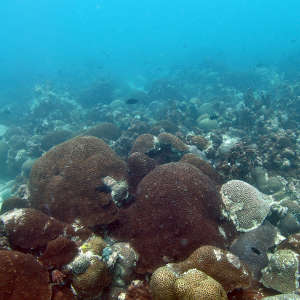Using AI to control energy for indoor agriculture
30 September 2024
Published online 17 January 2022
Examining the genetics of one coral species shows how a Persian/Arabian Gulf subpopulation has rapidly evolved to thrive in warmer waters.

Grace Vaughan
Now, Edward Smith at the University of North Carolina, and co-workers across the US and the Middle East, have examined the history, genetic connectivity, and genomic adaptation of a common pan-tropical brain coral, Platygyra daedalea, across the PAG and compared them with the same corals in the cooler Gulf of Oman.
“This coral is abundant and widespread in the tropics. It is already a valuable coral model, so there are extensive genomic resources available,” says Smith. “We know it is hardy, but the precise mechanisms conveying thermal tolerance in Platygyra daedalea from the PAG are unclear.”
The PAG is a young sea, having formed only 6,000 years ago, and its reefs are subjected to water temperatures above 34ºC in the summer months. In evolutionary terms, corals must have adapted to these high temperatures very quickly, and could therefore provide useful insights into how rapidly corals might adapt to climate change in other parts of the world.
The team collected corals from 15 reef sites across the north-eastern Arabian Peninsula and neighbouring regions, and used these to determine how the corals first spread into the PAG. The results suggest colonization followed a largely one-way flow of coral larvae, presumably restricted by the direction of surface currents between the PAG and the Indian Ocean.
“We identified a clear, genetically distinctive subpopulation of Platygyra daedalea living in the PAG that appears to have been established soon after the sea’s formation,” says Smith. “There is also a genetic split between the northern and southern PAG corals.”
The team analysed genome-wide markers to identify genetic differences in the southern PAG corals and the genetic loci that contribute to increased thermal tolerance. They found evidence of selection at a particular region of the genome that contains a genetic variant associated with larval survival at higher temperatures, and genes known to be involved in coral heat stress response.
“This study highlights why PAG reef-building corals are so special. Assessing and identifying coral communities with the best likelihood of surviving elevated temperatures is our most cost-effective conservation approach,” says Maoz Fine, marine ecologist at The Hebrew University of Jerusalem, Israel, who was not involved in the project.
“We are now following up this study to look for evidence of thermally tolerant genotypes outside the PAG,” says Smith. “It seems there is limited potential for PAG coral larvae to naturally seed Indian Ocean reefs.”
doi:10.1038/nmiddleeast.2022.1
Smith, E.G. et al. Signatures of selection underpinning coral adaptation to the world’s warmest reefs. Sci. Adv. 8, eabl7287 (2022).
Stay connected: